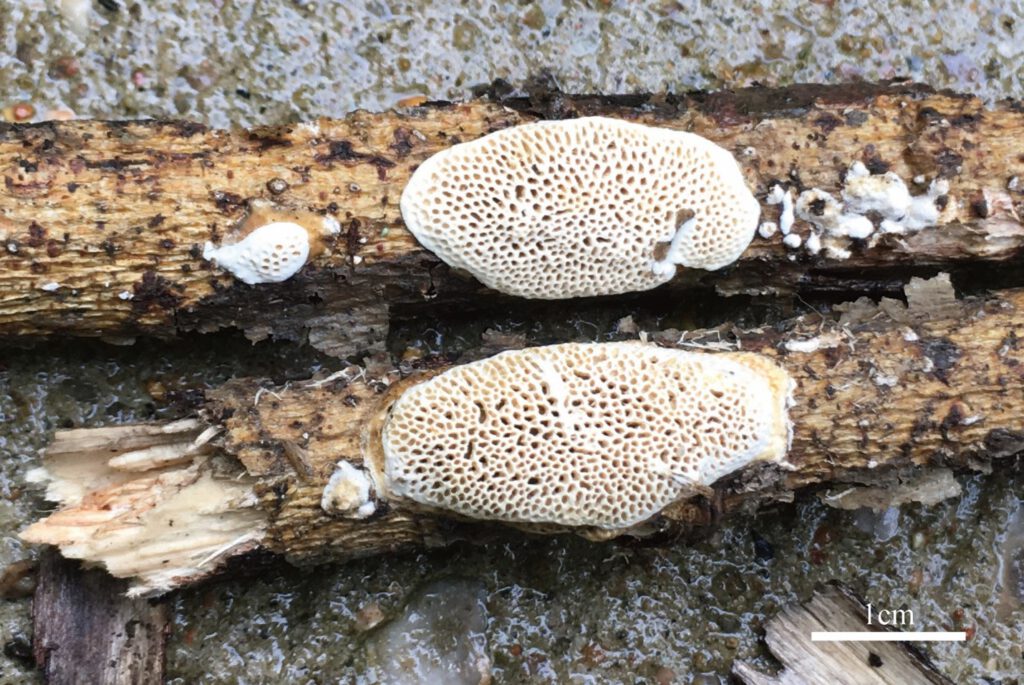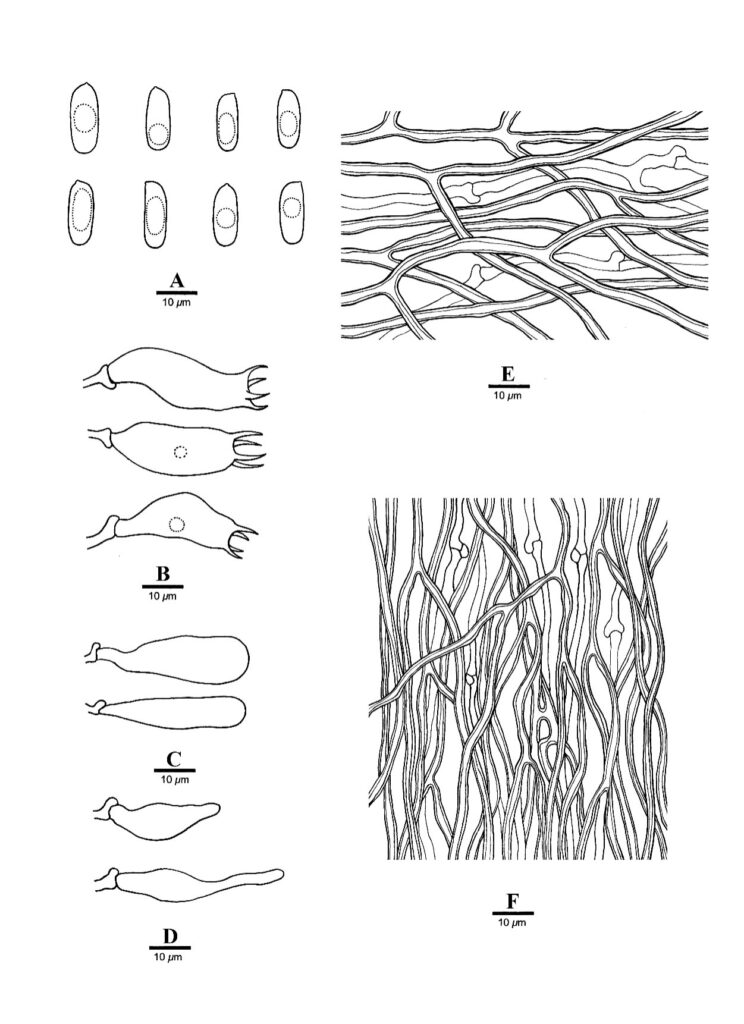Megasporoporiella hubeiensis
MycoBank number: MB 558815; Index Fungorum number: IF 558815; Facesoffungi number: FoF 10468;
Dichomitus hubeiensis Hai J. Li & B.K. Cui, Nordic Journal Botany 31: 118 (2013).
Description
Basidiocarps biennial, resupinate, cushion-shaped, corky, without odor or taste when fresh, becoming hard corky upon drying, up to 2.4 cm long, 12 cm wide, and 2.4 mm thick at center; sterile margin thinning out, very narrow to almost lacking. Pore surface white to cream when fresh, vinaceous buff to fulvous when dry; pores round to angular, 1–2 per mm; dissepiments thick, entire; subiculum pale buff, corky, up to 0.6 mm thick; tubes concolorous with the pore surface, corky, up to 1.8 mm long. Hyphal system dimitic; generative hyphae bearing clamp connections; skeletal hyphae IKI–, CB+; tissues unchanged in KOH. (not dissolved). Subicular generative hyphae hyaline, thin-walled, occasionally branched, 2.5–2.8 µm in diam; skeletal hyphae dominant, thick-walled with a narrow to medium lumen, frequently branched, mostly flexuous, interwoven, 2.8–3 µm in diam. Tramal generative hyphae hyaline, thin-walled, occasionally branched, 1.8–2.5 µm in diam; skeletal hyphae dominant, thick-walled with a narrow lumen, frequently branched, mostly flexuous, interwoven, 2.5–3 µm in diam. Dendrohyphidia present. Hyphal pegs absent. Cystidia absent; cystidioles present, subulate or ventricose, thin-walled, smooth, 18.2–37.2 × 6.3–10.5 µm. Basidia clavate, with four sterigmata and a basal clamp connection, 26.8–34.2 × 7.8–11.2 µm; basidioles in shape similar to basidia, but smaller. Small tetrahedric or polyhedric crystals frequently present among hymenium. Basidiospores cylindrical, hyaline, thin-walled, smooth, usually with one big guttule, IKI–, CB–, (11–)12–14.3(–14.8) × (4–)4.5–5.7(–6.5) µm, L = 13.26 µm, W = 5.12 µm, Q = 2.37–2.55 (n = 60/2).
Material examined: China, Hebei, Zhuolu County, Xiaowutai Natural Reserve, Shanjiankou, on dead branch of Salix, 10 September 2017, Y.C. Dai 18102 (BJFC025632), Y.C. Dai 18103 (BJFC025633); Hubei, Fang County, Shennongjia Natural Reserve, on fallen angiosperm branch, 22 September 2004, Wei 2045 (BJFC012314, holotype).
Distribution: China, Hebei Prov., Hubei Prov, Fang County
Sequence data: Wei2045 (Holotype) – ITS: JQ780387 (ITS5/ITS4); LSU: JQ780421 (LROR/LR7); MTSSU: KX838396 (MS1/MS2); Dai18102- ITS: MW694890 (ITS5/ITS4); LSU: MW694933 (LROR/LR7); MTSSU: MW694918 (MS1/MS2); EF1a: MZ618636 (983F/1567R); Dai18103- ITS: MW694891 (ITS5/ITS4); LSU: MW694934 (LROR/LR7); MTSSU: MW694919 (MS1/MS2);
Notes: Megasporoporiella hubeiensis was originally described as Dichomitus hubeiensis Hai J. Li & B.K. Cui from subtropical China (Li & Cui 2013a). But our phylogenies show the species nested in Megasporoporiella clade with a robust support (100 % MP, 100 % ML, 1.00 BPP). So, the above combination is proposed.

Fig. 1. Megasporoporiella hubeiensis (neotype). Basidiocarps of Megasporoporiella hubeiensis (the holotype, Dai 18102).

Fig. 2. Megasporoporiella hubeiensis (neotype). Microscopic structures of Megasporoporiella hubeiensis (drawn from Dai 18103). (A) Basidiospores; (B) Basidia; (C) Basidioles; (D) Cystidioles; (E). Hyphae from subiculum; (F) Hyphae from tube.
